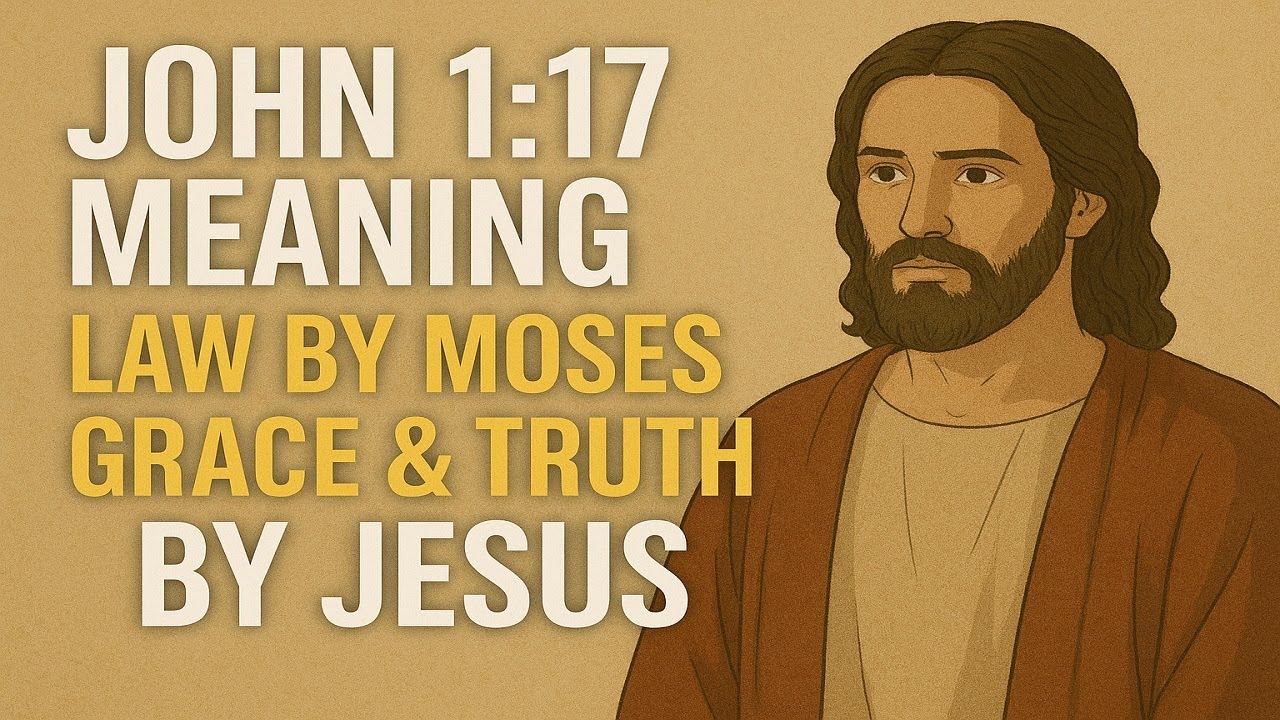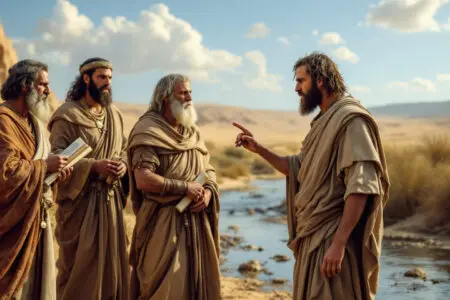Some verses just hit you differently. John 1:17 is one of those. “For the law was given through Moses; grace and truth came through Jesus Christ.” For the longest time, I’d just read that and think, “Yep, got it. Moses, Law. Jesus, grace.” Simple enough. But when you really stop and sit with it, the John 1:17 meaning isn’t just a simple fact.
It’s a continental shift in the story of God and people. It announces a whole new world. This isn’t about God scrapping the old plan for a new one. Not at all. It’s about a promise made in shadows finally stepping out into the sun. Getting this verse is the key to unlocking the whole Christian story—the move from a life of rule-following to a life of relationship.
More in John Chapter 1 Category
Key Takeaways
- A Divine Shift: John 1:17 highlights the massive change from the era of Mosaic Law to the new reality Jesus brought.
- Law’s Real Job: The Law from Moses was good and holy. It was meant to show God’s perfection, prove that we can’t be perfect on our own, and make us realize we need a savior. It defined the problem but couldn’t be the solution.
- Grace Explained: “Grace” is God’s totally unearned and undeserved kindness. It’s more than just forgiveness; it’s the life-changing power of His love, given freely because of Jesus, not because we earned it.
- Truth Made Real: “Truth” here is bigger than just correct facts. Jesus is the ultimate reality. He’s the perfect picture of who God is. He’s the real thing that the Law could only hint at.
- Fulfilled, Not Forgotten: Jesus didn’t come to throw the Law away. He came to complete it. Grace and truth aren’t the opposites of the Law; they are what the Law was pointing to all along.
Why Did the Law Come Through Moses Anyway?
To feel the full impact of “grace and truth,” we have to get a handle on the Law. It’s easy to think of it as a giant, dusty rulebook designed to make people feel bad. But that’s not what it was for. The Law was like a perfect mirror. Before it came, people knew they were messing up, but the picture was fuzzy. Then, on Mount Sinai, God gave them a crystal-clear standard. It showed His own perfect character and gave a blueprint for a holy people.
It was a good gift. It gave them structure, a just society, and a way to be different from all the nations around them. It showed them what righteousness looked like. But that mirror did something else, too. It showed every single flaw. With perfect clarity, it revealed that nobody could live up to that standard. The Law said, “Do this, and you’ll live,” but no one could actually “do this” without fail. It was the perfect diagnosis for the sickness of sin, but it couldn’t offer the cure.
Have You Ever Been Trapped by Rules?
I remember a few years ago when I decided I was going to get into the best shape of my life. I found this super intense workout plan online. It had rules for everything. What to eat, when to eat, which exercises to do on which day. I followed it perfectly for about two weeks. I felt like a champ—disciplined, righteous, and totally in control.
Then life happened.
A surprise business dinner. A sick kid who needed me. A terrible night’s sleep. I skipped a workout. I ate something off-plan. And just like that, the system that made me feel so in control became my prison. Every tiny slip-up felt like a huge failure. All the joy was sucked out of it, replaced by a nagging guilt that I just wasn’t good enough. The rules that were supposed to make me healthy ended up condemning me. That’s a tiny glimpse of what living under the Law is like. It’s a system based on your performance, and when you inevitably fail, you’re left with guilt, not grace.
What Does It Mean That Grace Came Through Jesus?
This is where the story turns. “Grace…came through Jesus Christ.” Grace is maybe the best word in the entire Bible. It’s getting what you absolutely don’t deserve. The Law demands that we be righteous. Grace hands us righteousness as a free gift.
Remember my failed fitness plan? A while later, I tried something new. Instead of a strict set of rules, I focused on principles. I learned about good nutrition, found exercises I actually liked, and gave myself permission to be human. It was about progress, not perfection. That little bit of “grace”—the freedom to have an off day without feeling like a total failure—made all the difference.
That’s a whisper of the real grace John is talking about. God saw that we couldn’t meet His perfect standard. So He didn’t lower the standard; He met it for us. Through Jesus’s perfect life, his death on the cross, and his resurrection, God offers us the very perfection the Law demanded. It’s not about trying harder. It’s about trusting what He has already done. It is a gift.
And What About the “Truth” He Brought?
Grace doesn’t show up by itself. John pairs it with truth: “grace and truth came through Jesus Christ.” If grace is how God feels about us, truth is the solid reality of who He is. The old system was full of shadows and copies—the sacrifices, the temple, the priests. They were all important, but they were pointers to something real that was still to come. Jesus is that reality.
He is the real sacrifice. He is the real temple. He is the real priest.
The “truth” Jesus brings isn’t just a list of things to believe. He is the truth. He’s the one who makes all of God’s promises come true. He’s the final and clearest picture of what God the Father is like. The Law was a charcoal sketch; Jesus showed up in living color.
- The Law pointed to a sacrifice that would one day cover sin. Jesus is that sacrifice.
- The Law set up a system for people to approach God through a priest. Jesus is our priest and the direct way to the Father.
- The Law was a covenant written on stone tablets. Jesus brought a new covenant written on our hearts.
He is the Truth that frees us from the lie that we have to earn our way to God.
Did Jesus Just Get Rid of the Law?
That’s a fair question. If grace is so great, is the Law now bad or useless? Absolutely not. Jesus made this clear himself: “Do not think that I have come to abolish the Law or the Prophets; I have not come to abolish them but to fulfill them” (Matthew 5:17). Jesus is what the Law was aiming for all along.
I once had a major problem with a coworker. From my perspective, based on a few missed deadlines and short emails, he was lazy. I was judging him by the “law” of the workplace, and he was failing. I was ready to complain.
But then a friend who knew the whole story pulled me aside and gave me the “truth.” My coworker’s wife was terribly sick. He was juggling work from her hospital room and taking care of their kids. He was exhausted. The truth didn’t change the fact that deadlines were missed. But it changed everything about how I saw the situation. My judgment melted into compassion. The “law” wasn’t wrong, but the “grace and truth” of the real story brought a much better way forward. That’s how Jesus fulfills the Law. He doesn’t ignore its standards; he completes them with God’s unstoppable, compassionate love.
How Does Grace and Truth Change How We Live?
This whole idea isn’t just for Sunday school. The John 1:17 meaning changes real life, right now. Living in grace and truth pulls us off the treadmill of performance and religiousut.
Here’s the dt looks:
- Motivation: The Law runs on fear and pride. Grace runs on love and gratitude. You don’t obey God to earn his love; you obey and g Him because you already have it.
- Power: The Law could tell you not to be greedy, but it couldn’t stop you from wanting more. The grace of God, through His Spirit, actually changes what we want from the inside out.
- Identity: Under the Law, Holy Sp theirit, you are what you do. Your value goes up and down with your last success or failure. In grace, you are who God says you are because of Jesus. Your identity is rock-solid and secure.
- Relationship: The Law keeps God at a distance—He’s the judge. Grace brings us close and makes us family. We y and obon.
T it all. It means your worst days can’t disqualify you and your best days can’t justify you. You stand based entirely on the whatsolid has done. Period.f Jesus Christ. For more on the theological context of John’s writings, the Laney Graduate School at Emory University offers deep insights into biblical studies and early Christianity.
So, Are We Under Law or Grace?
John 1:17 presents a clear distinction. The system of rules and regulations required for righteousness—the Mosaic covenant—has been fulfilled. Believers in Christ now live under a new covenant, the covenant of grace. This doesn’t mean we live lawless lives. On the contrary, grace teaches us to say “No” to ungodliness (Titus 2:11-12). The moral principles of the Law, which reflect God’s unchanging character, are now written on our hearts by the Spirit.
We obey not out of a desperate attempt to earn favor, but out of a joyful response to the favor we have already freely received. It’s the difference between a child grudgingly doing chores to get an allowance and a child joyfully cleaning their room because they love their parents and are part of the family. The action might look the same, but the heart, the motivation, is worlds apart. The first is Law. The second is grace.
FAQ – John 1:17 Meaning

What practical impact does understanding John 1:17 have on how we live today?
Understanding John 1:17 encourages believers to live motivated by love and gratitude rather than fear or pride, to seek internal transformation through God’s Spirit, and to see their identity and relationship with God as secure, free from condemnation and performance-based standards.
How does Jesus fulfill the Law according to the article?
Jesus fulfills the Law by completing its perfect standards through His life, death, and resurrection. He embodies the true sacrifice, priesthood, and covenant the Law pointed towards, transforming its purpose from mere rule-keeping to a relationship based on grace and truth.
What is the significance of grace in the context of John 1:17?
Grace is God’s unearned kindness that offers forgiveness and the power for a transformed life. It signifies that righteousness is a gift from God, made possible through Jesus, and not something we can earn through our own efforts.
Why did the Law come through Moses, and what was its purpose?
The Law was given through Moses to serve as a perfect mirror that revealed God’s character and provided guidelines for righteousness, but it could not save or make people perfect. It showed the standard but highlighted human inability to meet it, pointing to the need for a savior.






